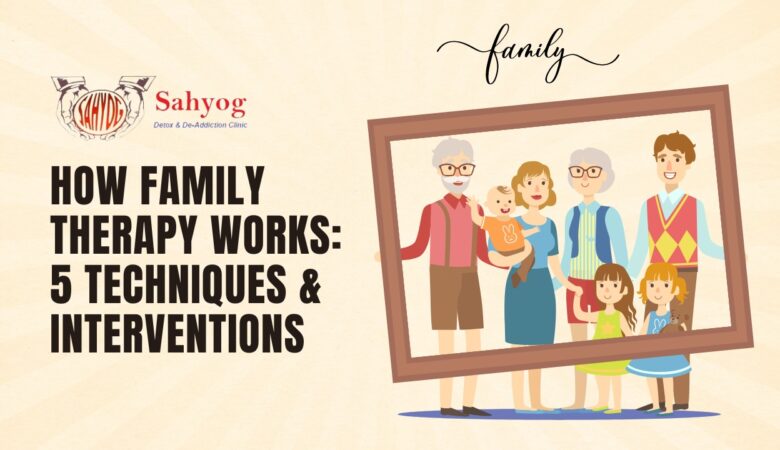How Family Therapy Works: 5 Techniques & Interventions
Introduction Family therapy is a type of counselling that helps families improve communication, resolve conflict, and address other issues. It can be an effective treatment for mental and emotional disorders that affect the family unit. If you’re considering family therapy, you may be wondering how it works. In this blog, we’ll try our best to work out the same! In this blog, we will discuss with you the 5 techniques and interventions that are used in the therapy. Read on to know more. What is Family Therapy? In family therapy, practitioners work with families and couples to help them improve communication and resolve conflict. This type of therapy can be beneficial for families who are dealing with a variety of issues, including substance abuse, domestic violence, mental illness, and parenting issues. This therapy can also be helpful for families who are struggling to cope with a major life event, such as the death of a loved one or divorce. What are the Benefits? The therapy has many benefits, both for the family as a whole and for each member. From improving communication and managing conflict to resolving issues from the past and developing stronger relationships, family therapy can help families in many ways. Some of the specific benefits include: Improved communication: One of the main goals of family therapy is to improve communication between family members. This can help resolve conflict, build closer relationships, and make it easier to discuss sensitive topics. Resolution of past issues: The therapy can also help resolve issues from the past that may be impacting the present. This could include things like childhood trauma or unresolved conflict between siblings. Increased understanding: Another benefit is that it can help increase understanding between family members. Through discussion and exploration in therapy, families can learn more about each other’s perspectives and experiences. Stronger relationships: Ultimately, one of the most important benefits of family therapy is that it can help strengthen relationships within the family. This could involve developing new skills for managing conflict or simply spending more time talking and connecting. How does family therapy work? The family is the foundation of society. It is the first social system to which a child is exposed and it is the primary source of a person’s sense of self. This therapy works by taking a systems approach to problem-solving within the family unit. Systems theory posits that families are complex, dynamic systems made up of interdependent parts. This means that when one member of the system experiences a problem or change, it will have an effect on the other members and the system as a whole. The goal of the therapy is to help families identify and understand these patterns of behaviour and communication so that they can make changes to improve their overall functioning. There are a variety of techniques and interventions used in family therapy, all of which are based on this system’s approach. Some common methods include behavioural contracts, role-playing, and communication exercises. Therapists may also use more creative approaches such as art or music therapy. The specific interventions used will be tailored to the needs of each family. The therapy can be an effective treatment for a wide range of issues, including marital problems, parenting issues, substance abuse, mental health disorders, and life transitions such as divorce or death. It can also be helpful for families who are struggling with chronic illness or disability. By working together with a therapist, families can learn new ways to communicate and connect, build stronger relationships, and resolve conflict in healthier ways. 5 Techniques & Interventions of Family Therapy The techniques and interventions used in this therapy can vary depending on the therapist and the specific needs of the family. Here are five common techniques: Structural family therapy: The structuring family therapy technique intervenes in family communication patterns to improve the functioning of the family as a whole. Strategic family therapy: The Strategic family therapy technique focuses on specific goals and changeable behaviours within the family system. Systemic therapy: The Systemic therapy technique views the family as a complex system with interacting parts. Psychodynamic therapy: The Psychodynamic therapy technique explores unconscious processes within the family that may be contributing to current problems. Solution-focused therapy: The Solution-focused therapy technique helps families identify and build on their strengths to find solutions to current challenges. However, some common interventions are also used in this therapy. These interventions can be divided into five main categories: communication interventions, problem-solving interventions, conflict-resolution interventions, family therapy sessions, and individual counselling. Communication Interventions: Communication interventions are designed to help improve communication within the family. This may involve teaching families how to communicate more effectively with each other or helping them to understand and express their feelings more openly. Problem-solving interventions: Problem-solving interventions are focused on helping families identify and solve problems that they are experiencing. This may involve brainstorming solutions to problems, role-playing different scenarios, or teaching families how to negotiate and compromise. Conflict-resolution interventions: Conflict-resolution interventions are designed to help families resolve conflicts that they are experiencing. This may involve teaching families how to communicate more effectively with each other, identifying areas of agreement and disagreement, or helping families to develop a plan for resolving their conflict. Family therapy sessions: One common intervention is family therapy sessions. These sessions usually last for an hour or more, and they provide a time and space for the family to talk openly about their problems. The therapist will help the family to identify patterns of behaviour that are contributing to the problem, and they will work together to find new ways to deal with the problem. Individual counselling: Another common intervention is individual counselling. In this type of counselling, the therapist meets with each member of the family individually. This allows the therapist to get a better understanding of each person’s perspective on the problem, and it also allows them to work on specific issues with each person. Family therapy can also involve other types of interventions, such as


